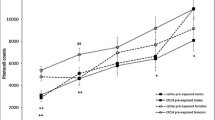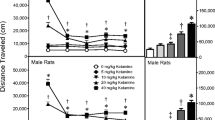Abstract
Rationale
Most adult smokers start smoking during their adolescence. This adolescent initiation may be due to multiple factors, but little evidence is available regarding whether their brains are differentially sensitive to the addictive effects of nicotine during adolescence.
Objective
To test the hypothesis that adolescents are more sensitive than adults to nicotine’s rewarding actions.
Methods
An unbiased, counterbalanced, place-conditioning procedure was used to examine drug-induced reward and locomotor activity. Early adolescent (postnatal day 28), late adolescent (P38) and adult (P90) rats received either saline or nicotine (0.125, 0.25 or 0.5 mg/kg, s.c.) and were tested for place conditioning.
Results
During early adolescence, a single nicotine injection (0.5 mg/kg) induced significant conditioned place preference (CPP). In contrast, during late adolescence or adulthood, nicotine did not induce CPP after either one or four conditioning trials. Initial locomotor responses to acute nicotine administration during the first conditioning trial also differed with age, with no effect at P28, but substantial inhibitory responses at all doses studied (0.125–0.5 mg/kg) at later ages. Although not differing in their initial locomotor response to nicotine, there was a significantly greater tolerance/sensitization during the second and subsequent drug exposures in late adolescents than in adults.
Conclusions
These findings provide evidence that adolescent brain is differentially sensitive to both the acute and repeated effects of nicotine relative to adult brain. Furthermore, there are significant differences in nicotine sensitivity between early and late phases of adolescence.





Similar content being viewed by others
References
Adriani W, Macri S, Pacifici R, Laviola G (2002) Peculiar vulnerability to nicotine oral self-administration in mice during early adolescence. Neuropsychopharmacology 27:212–224
Adriani W, Spijker S, Deroche-Gamonet V, Laviola G, Le Moal M, Smit AB, Piazza PV (2003) Evidence for enhanced neurobehavioral vulnerability to nicotine during periadolescence in rats. J Neurosci 23:4712–4716
Andersen SL, Teicher MH (2000) Sex differences in dopamine receptors and their relevance to ADHD. Neurosci Biobehav Rev 24:137–141
Andersen SL, Dumont NL, Teischer MH (1997) Developmental differences in dopamine synthesis inhibition by (+/-)-7-OH-DPAT. Naunyn Schmiedebergs Arch Pharmacol 356:173–181
Andersen SL, Thompson AT, Rutstein M, Hostetter JC, Teicher MH (2000) Dopamine receptor pruning in prefrontal cortex during the periadolescent period in rats. Synapse 37:167–169
Balfour DJ, Benwell ME, Birrell CE, Kelly RJ, Al-Aloul M (1998) Sensitization of the mesoaccumbens dopamine response to nicotine. Pharmacol Biochem Behav 59:1021–1030
Benes FM, Taylor JB, Cunningham MC (2000) Convergence and plasticity of monoaminergic systems in the medial prefrontal cortex during the postnatal period: implications for the development of psychopathology. Cereb Cortex 10:1014–1027
Benwell ME, Balfour DJ (1997) Regional variation in the effects of nicotine on catecholamine overflow in rat brain. Eur J Pharmacol 325:13–20
Bevins RA, Besheer J (2001) Individual differences in rat locomotor activity are diminished by nicotine through stimulation of central nicotinic acetylcholine receptors. Physiol Behav 72:237–244
Breslau N, Peterson EL (1996) Smoking cessation in young adults: age at initiation of cigarette smoking and other suspected influences. Am J Public Health 86:214–220
Breslau N, Fenn N, Peterson EL (1993) Early smoking initiation and nicotine dependence in a cohort of young adults. Drug Alcohol Depend 33:129–137
Calcagnetti DJ, Schechter MD (1994) Nicotine place preference using the biased method of conditioning. Prog Neuropsychopharmacol Biol Psychiatry 18:925–933
Carboni E, Acquas E, Leone P, Di Chiara G (1989) 5HT3 receptor antagonists block morphine- and nicotine- but not amphetamine-induced reward. Psychopharmacology 97:175–178
Carr GD, Fibiger HC, Phillips AG (1989) Conditioned place preference as a measure of drug reward. In: Liebman JM, Cooper SJ (eds) Neuropharmacological basis of reward. Oxford University Press, New York, pp 264–319
Chen J, Millar WJ (1998) Age of smoking initiation: implications for quitting. Health Rep 9:39–46
Clarke PB, Fibiger HC (1987) Apparent absence of nicotine-induced conditioned place preference in rats. Psychopharmacology 92:84–88
Corrigall WA, Franklin KB, Coen KM, Clarke PB (1992) The mesolimbic dopaminergic system is implicated in the reinforcing effects of nicotine. Psychopharmacology 107:285–289
Di Chiara G (2000) Role of dopamine in the behavioural actions of nicotine related to addiction. Eur J Pharmacol 393:295–314
DiFranza JR, Savageau JA, Fletcher K, Ockene JK, Rigotti NA, McNeill AD, Coleman M, Wood C (2002) Measuring the loss of autonomy over nicotine use in adolescents: the DANDY (Development and Assessment of Nicotine Dependence in Youths) study. Arch Pediatr Adolesc Med 156:397–403
Faraday MM, Elliott BM, Grunberg NE (2001) Adult vs. adolescent rats differ in biobehavioral responses to chronic nicotine administration. Pharmacol Biochem Behav 70:475–489
Fudala PJ, Teoh KW, Iwamoto ET (1985) Pharmacologic characterization of nicotine-induced conditioned place preference. Pharmacol Biochem Behav 22:237–241
Giedd JN, Blumenthal J, Jeffries NO, Castellanos FX, Liu H, Zijdenbos A, Paus T, Evans AC, Rapoport JL (1999) Brain development during childhood and adolescence: a longitudinal MRI study. Nat Neurosci 2:861–863
Jorenby DE, Steinpreis RE, Sherman JE, Baker TB (1990) Aversion instead of preference learning indicated by nicotine place conditioning in rats. Psychopharmacology 101:533–538
Kandel DB, Chen K (2000) Extent of smoking and nicotine dependence in the United States: 1991–1993. Nicotine Tob Res 2:263–274
Khuder SA, Dayal HH, Mutgi AB (1999) Age at smoking onset and its effect on smoking cessation. Addict Behav 24:673–677
Lambe EK, Krimer LS, Goldman-Rakic PS (2000) Differential postnatal development of catecholamine and serotonin inputs to identified neurons in prefrontal cortex of rhesus monkey. J Neurosci 20:8780–8787
Laviolette SR, van der Kooy D (2003) Blockade of mesolimbic dopamine transmission dramatically increases sensitivity to the rewarding effects of nicotine in the ventral tegmental area. Mol Psychiatry 8:50–59
Laviolette SR, Alexson TO, van der Kooy D (2002) Lesions of the tegmental pedunculopontine nucleus block the rewarding effects and reveal the aversive effects of nicotine in the ventral tegmental area. J Neurosci 22:8653–8660
Lewis DA, Akil M (1997) Cortical dopamine in schizophrenia: strategies for postmortem studies. J Psychiatr Res 31:175–195
Martin JL, Itzhak Y (2000) 7-Nitroindazole blocks nicotine-induced conditioned place preference but not LiCl-induced conditioned place aversion. Neuroreport 11:947–949
Moll GH, Mehnert C, Wicker M, Bock N, Rothenberger A, Ruther E, Huether G (2000) Age-associated changes in the densities of presynaptic monoamine transporters in different regions of the rat brain from early juvenile life to late adulthood. Brain Res Dev Brain Res 119:251–257
Olausson P, Akesson P, Engel JA, Soderpalm B (2001) Effects of 5-HT1A and 5-HT2 receptor agonists on the behavioral and neurochemical consequences of repeated nicotine treatment. Eur J Pharmacol 420:45–54
Reid MS, Ho LB, Berger SP (1996) Effects of environmental conditioning on the development of nicotine sensitization: behavioral and neurochemical analysis. Psychopharmacology 126:301–310
Shoaib M, Stolerman IP, Kumar RC (1994) Nicotine-induced place preferences following prior nicotine exposure in rats. Psychopharmacology 113:445–452
Slawecki CJ, Ehlers CL (2002) Lasting effects of adolescent nicotine exposure on the electroencephalogram, event related potentials, and locomotor activity in the rat. Brain Res Dev Brain Res 138:15–25
Slotkin TA (2002) Nicotine and the adolescent brain: insights from an animal model. Neurotoxicol Teratol 24:369–384
Sowell ER, Thompson PM, Tessner KD, Toga AW (2001) Mapping continued brain growth and gray matter density reduction in dorsal frontal cortex: inverse relationships during postadolescent brain maturation. J Neurosci 21:8819–8829
Spear LP (2000) The adolescent brain and age-related behavioral manifestations. Neurosci Biobehav Rev 24:417–463
Taioli E, Wynder EL (1991) Effect of the age at which smoking begins on frequency of smoking in adulthood. N Engl J Med 325:968–969
Tarazi FI, Baldessarini RJ (2000) Comparative postnatal development of dopamine D(1), D(2) and D(4) receptors in rat forebrain. Int J Dev Neurosci 18:29–37
Tirelli E, Laviola G, Adriani W (2003a) Ontogenesis of behavioral sensitization and conditioned place preference induced by psychostimulants in laboratory rodents. Neurosci Biobehav Rev 27:163–178
Tirelli E, Tambour S, Michel A (2003b) Sensitised locomotion does not predict conditioned locomotion in cocaine-treated mice: further evidence against the excitatory conditioning model of context-dependent sensitisation. Eur Neuropsychopharmacol 13:289–96
Trauth JA, Seidler FJ, McCook EC, Slotkin TA (1999) Adolescent nicotine exposure causes persistent upregulation of nicotinic cholinergic receptors in rat brain regions. Brain Res 851:9–19
Trauth JA, Seidler FJ, Ali SF, Slotkin TA (2001) Adolescent nicotine exposure produces immediate and long-term changes in CNS noradrenergic and dopaminergic function. Brain Res 892:269–280
Vastola BJ, Douglas LA, Varlinskaya EI, Spear LP (2002) Nicotine-induced conditioned place preference in adolescent and adult rats. Physiol Behav 77:107–114
Acknowledgements
This work was supported by NIH grant DA13332. The authors would like to thank Dr. Sandra Loughlin for her valuable advice.
Author information
Authors and Affiliations
Corresponding author
Rights and permissions
About this article
Cite this article
Belluzzi, J.D., Lee, A.G., Oliff, H.S. et al. Age-dependent effects of nicotine on locomotor activity and conditioned place preference in rats. Psychopharmacology 174, 389–395 (2004). https://doi.org/10.1007/s00213-003-1758-6
Received:
Accepted:
Published:
Issue Date:
DOI: https://doi.org/10.1007/s00213-003-1758-6




